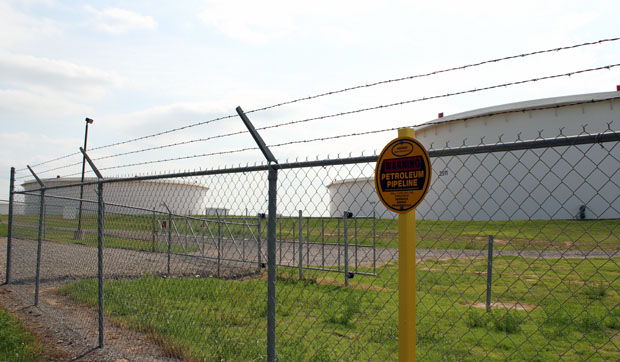
The Glass Mountain Pipeline would carry crude oil from Arnett and Alva, Okla. to the storage and distribution hub in Cushing.
Joe Wertz / StateImpact Oklahoma


The Glass Mountain Pipeline would carry crude oil from Arnett and Alva, Okla. to the storage and distribution hub in Cushing.
Joe Wertz / StateImpact Oklahoma

Joe Wertz / StateImpact Oklahoma
The Glass Mountain Pipeline would carry crude oil from Arnett and Alva, Okla. to the storage and distribution hub in Cushing.
Landowners in Major County who depend on aquifer water say a planned crude oil pipeline threatens the Cimarron Aquifer — their primary water source.
Rural homeowners use well water from the aquifer, which also feeds nearby towns and comprises about 87 percent of nearby Enid’s permitted water production.
Oklahomans in the area are puzzled about the Glass Mountain Pipeline route, the Enid News & Eagle‘s James Neal reports:
Landowners, conservationists and Cimarron Aquifer consumers may wonder why any regulatory agency would approve a pipeline route through the “heart of our aquifer.”
But no state or federal agency or entity has authority over Oklahoma pipeline projects until construction has started, or until there’s a problem — like a leak.
The biggest pipeline project in Oklahoma, the Keystone XL pipeline, is up against federal regulation because it crosses the international border with Canada. The State Department, The U.S. Fish and Wildlife Service and the U.S. Army Corps of Engineers all have a say in various stages of that crude oil pipeline, which passes through the Cushing storage hub on its way from Canada’s oil sands to refineries along Texas’ Gulf Coast.
But intrastate pipeline projects — like the Glass Mountain Pipeline — aren’t regulated until construction has started, or until there’s an environmental problem.
The Glass Mountain Pipeline — a joint venture of Chesapeake Energy, Tulsa’s SemGroup and Gavilon — is a 210-mile pipeline that will carry crude from Arnett and Alva to the Cushing storage hub. The Arnett and Alva pipeline segments will join near Cleo Springs, which sits atop the Cimarron River Aquifer.
The pipeline project was announced in May. The Arnett and Alva pipeline segments are expected to carry about 90,000 barrels of crude each day. The combined pipeline will have a 180,000 barrel-per-day capacity.
But when it comes to pipelines, route is everything.
Keystone XL was waylaid by environmental concerns in Nebraska, where it was originally planned to cross the ecologically sensitive Sand Hills and parts of the Ogallala Aquifer. The company behind the pipeline, TransCanada, had to reroute Keystone XL, which had become a presidential campaign issue.
Keystone XL has faced other routing issues, including fights with Oklahoma and Texas landowners over eminent domain, and concern among tribal leaders that construction could unearth unmarked graves or expose sacred archeological sites.
But route alone isn’t enough for a pipeline project to be regulated.
Oklahoma’s Corporation Commission, which regulates oil and gas drilling, doesn’t have any authority in the early stages of pipeline construction, the Eagle reports:
Once the pipeline is built, we make sure the line is operated properly and meets material safety rules … but we don’t have much to do with it until it’s built,” said Matt Skinner, spokesman for Oklahoma Corporation Commission.
What about the state Department of Environmental Quality?
… DEQ only becomes involved with pipelines if there is a spill, and then only in a support role to the corporation commission.
Since the aquifer is a primary concern among landowners in Glass Mountain’s path, maybe the Oklahoma Water Resources Board?
Brian Vance, director of information for Oklahoma Water Resources Board, said OWRB has no authority over pipeline routes or their potential impact to groundwater.
On the federal level, representatives from both the Environmental Protection Agency and the Federal Energy Regulatory Commission tell the Eagle they have no authority over a private pipeline project that doesn’t cross state lines. And no representative from any state or federal agency could think of any other state or federal agency with authority over a project like Glass Mountain, Neal writes.